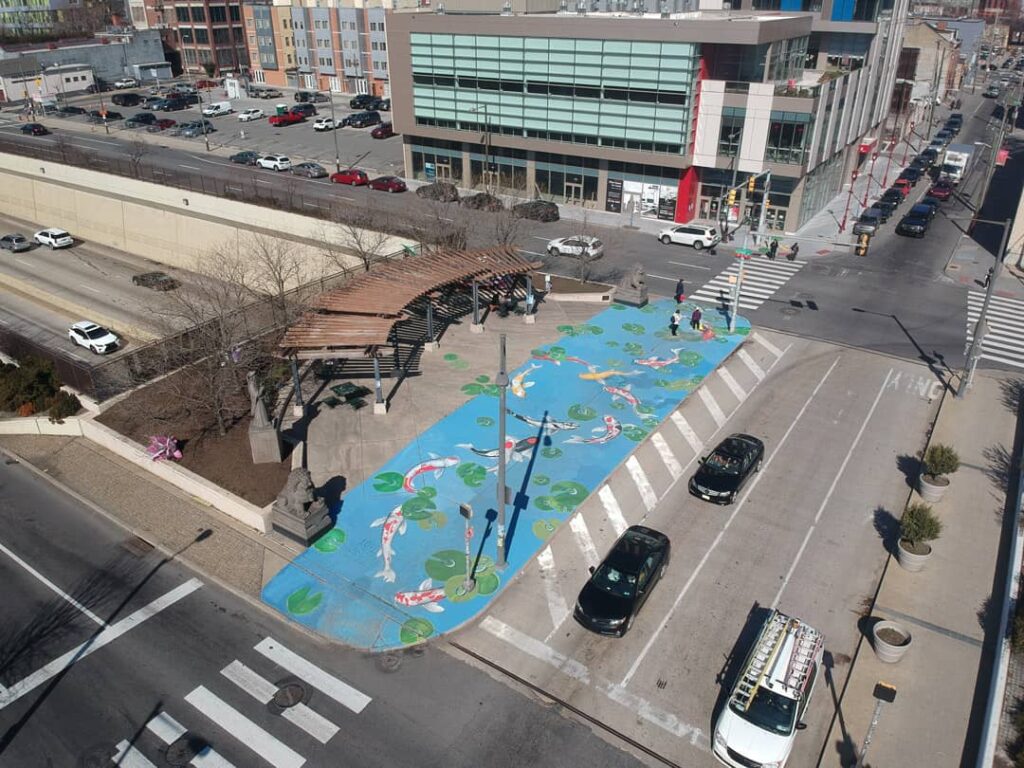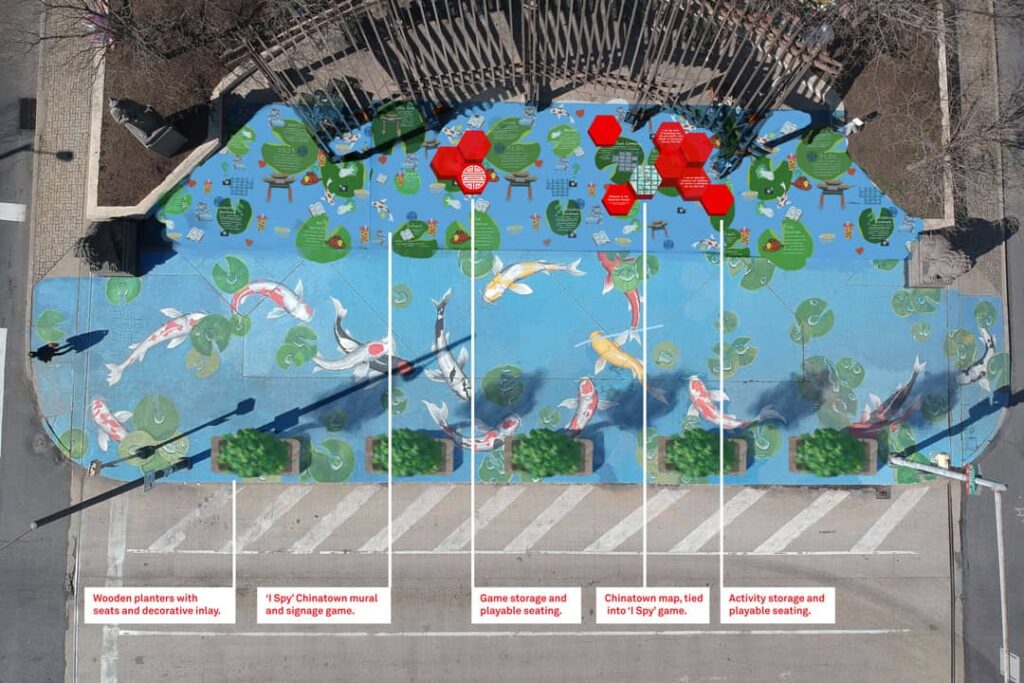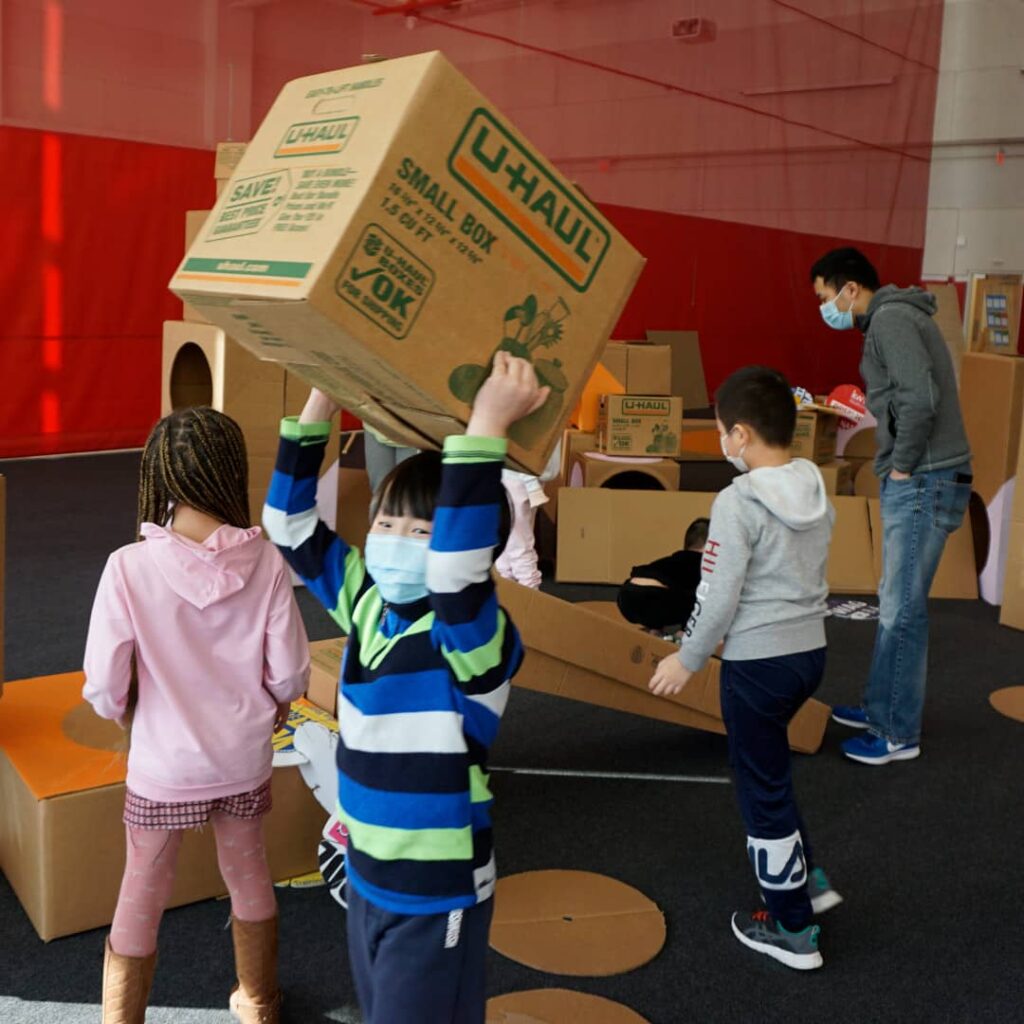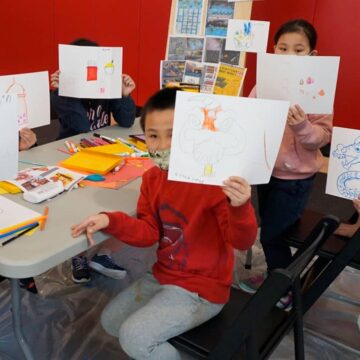Philadelphia Chinatown Development Corporation is transforming the 10th Street Plaza into a hub for literacy, active play, and cultural connection.
This is the first in a series of Stories about winners from Play Everywhere Philly. See other stories from this series. Learn more about Play Everywhere Philly.
Every day, hundreds of children and families cross through Philadelphia’s 10th Street Plaza on their way to school and work. Located between six lanes of busy traffic, the plaza is one of the few outdoor gathering areas in Chinatown, a densely-populated neighborhood just north of Center City where many Chinese-American residents live, work and play.
Prior to 2019, the plaza was no more than a concrete island between two busy street crossings. Hoping to improve the pedestrian experience and encourage community gathering, the Philadelphia Chinatown Development Corporation (PCDC) commissioned Chenlin Cai, a local artist trained at China’s elite Tsighua University, to adorn the plaza with a sidewalk mural depicting colorful koi fish and lily pads.
Since the mural’s installation, the 10th Street Plaza has transformed into a livelier space, with families pausing to take pictures of the art and kids hopping along the path of lily pads or playing with the koi fish.

A Representation of Culture
The mural is a representation of culture for Chinatown residents, says Yue Wu, a community planner for the PCDC. This year, as one of 16 winners of Play Everywhere Philly, our program to bring playful learning opportunities to public installations across the city, the PCDC will further transform the plaza into a “PlayZa.”
The updated, more playful space will incorporate a map of Chinatown, games, and interactive learning features designed to foster not only literacy and active play, but also cultural learning.

“We want to make Chinatown an intergenerational neighborhood, a place for everyone,” said Wu. In a community where language barriers can exist between English-speaking children and their Mandarin- or Cantonese-speaking parents, the PCDC’s goal is to create a playspace that informs cultural identity in a manner accessible to all. For example, the interactive map will depict local landmarks — including the Chinatown Arch, schools and daycare centers, and beloved businesses — with names listed in multiple languages.
That emphasis on cultural identity is important for a community with such strong ties to its heritage. Chinatown has acted as a home away from home for Chinese immigrants for 150 years and has in many ways remained authentically Chinese. However, continued preservation is a challenge as the Center City neighborhood faces pressure to develop. Historically, urban renewal projects such as the Vine Street Expressway have threatened to displace residents, especially renters, and limit community growth.

A Partnership that Creates Playful Learning Opportunities
KABOOM!, with funding from the William Penn Foundation, launched Play Everywhere Philly to create more opportunities for playful learning in neighborhood spaces and support child development and literacy skills.
Wu believes that the PlayZa is important for her community in additional ways. A safe place to play can help alleviate the stressors children can face as a result of disinvestment, including poverty and racial discrimination. It could also help increase Chinatown’s visibility, educate visitors about the neighborhood’s residents and culture, and encourage residents’ ownership of their community’s development.
Engaging the Community Fosters Ownership
PCDC’s community engagement plan for the project will help drive that aspect of ownership. Initially, PCDC worked to gauge the community’s reaction to the mural. Public events such as game night popularized the space, but Wu said that it was not widely used when there was no programming scheduled. PCDC hopes that ideas incorporated into their Play Everywhere design, such as playful structures and permanent storage for games, will attract families to use the space more regularly.




Kids in the neighborhood are playing an important role in designing those structures. Mural artists are hosting virtual classes at Chinatown schools, asking students to draw anything that is important to them in Chinatown. Using those designs, the muralists will put together preliminary designs for the interactive map and present them to kids for additional feedback. During an in-person engagement activity, kids built out their own replicas of the plaza using cardboard boxes, offering inspiration for the final design.
These engagement sessions will help ensure that the new playspace reflects the wishes of kids who will use it. They have guided the direction of the project, and, for Wu, confirmed the PCDC’s original intention.
“The cultural heritage of Chinatown is so precious for our community members,” said Wu. “We asked them what they wanted to feel [from the PlayZa]. It really confirmed our direction. We want to create a space where they feel familiar and safe.”
We want to create a space where they feel familiar and safe.
Yue Wu, community planner for Philadelphia Chinatown Development Corporation
Until the PlayZa is fully installed, kids in Chinatown lack access to space that is designed specifically for them.
Chinatown is a busy neighborhood with lots of traffic, and it is often unsafe for kids to play outside or walk to a designated playspace without supervision. Aside from a community center which opened up in 2019, kids do not have any nearby public spaces to play safely or interact with their caregivers.
The COVID-19 pandemic has only exacerbated this problem, highlighting an inequity that is common in neighborhoods facing historic disinvestment. And as Asian Americans continue to experience discrimination and harassment — with nearly 10 percent of reported occurrences taking place in public parks — creating belonging and cultural relevancy in Chinatown’s public spaces is more important than ever.
